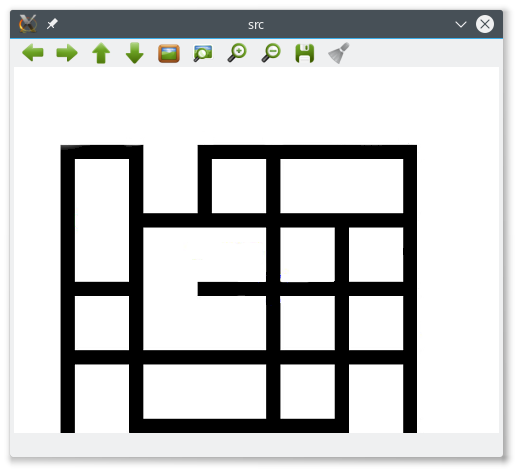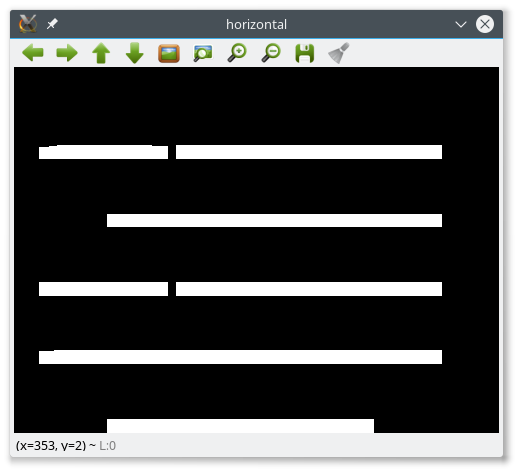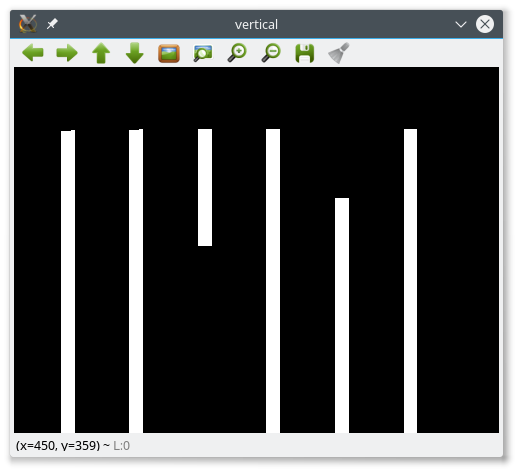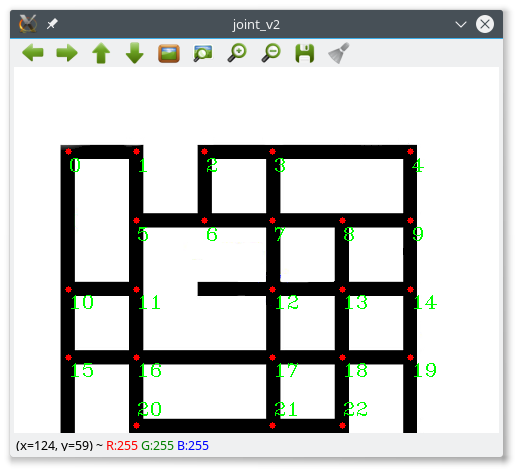This forum is disabled, please visit https://forum.opencv.org
 | 1 | initial version |
An example in C++ that can easily ported in python is the following:
#include <iostream>
#include <opencv2/opencv.hpp>
using namespace std;
using namespace cv;
int main()
{
// Load source image
string filename = "nodes.bmp";
Mat src = imread(filename);
// Check if image is loaded fine
if(!src.data)
cerr << "Problem loading image!!!" << endl;
// Show source image
imshow("src", src);
// Transform source image to gray if it is not
Mat gray;
if (src.channels() == 3)
{
cvtColor(src, gray, CV_BGR2GRAY);
}
else
{
gray = src;
}
// Show gray image
imshow("gray", gray);
// Apply threshold to grayscale image
Mat bw;
threshold(gray, bw, 50, 255, THRESH_BINARY || THRESH_OTSU);
// Show binary image
imshow("binary", bw);
// Create the images that will use to extract the horizonta and vertical lines
Mat horizontal = bw.clone();
Mat vertical = bw.clone();
// Specify size on horizontal axis
int horizontalsize = horizontal.cols / 10;
// Create structure element for extracting horizontal lines through morphology operations
Mat horizontalStructure = getStructuringElement(MORPH_RECT, Size(horizontalsize,1));
// Apply morphology operations
erode(horizontal, horizontal, horizontalStructure, Point(-1, -1));
dilate(horizontal, horizontal, horizontalStructure, Point(-1, -1));
dilate(horizontal, horizontal, horizontalStructure, Point(-1, -1)); // expand horizontal lines
// Show extracted horizontal lines
imshow("horizontal", horizontal);
// Specify size on vertical axis
int verticalsize = vertical.rows / 10;
// Create structure element for extracting vertical lines through morphology operations
Mat verticalStructure = getStructuringElement(MORPH_RECT, Size( 1,verticalsize));
// Apply morphology operations
erode(vertical, vertical, verticalStructure, Point(-1, -1));
dilate(vertical, vertical, verticalStructure, Point(-1, -1));
dilate(vertical, vertical, verticalStructure, Point(-1, -1)); // expand vertical lines
// Show extracted vertical lines
imshow("vertical", vertical);
Mat joints;
bitwise_and(horizontal, vertical, joints);
imshow("joints", joints);
vector<vector<Point> > contours;
findContours(joints, contours, RETR_CCOMP, CHAIN_APPROX_SIMPLE);
/// Get the moments
vector<Moments> mu(contours.size() );
for( size_t i = 0; i < contours.size(); i++ )
{ mu[i] = moments( contours[i], false ); }
/// Get the mass centers:
vector<Point2f> mc( contours.size() );
for( size_t i = 0; i < contours.size(); i++ )
{ mc[i] = Point2f( mu[i].m10/mu[i].m00 , mu[i].m01/mu[i].m00 ); }
struct Less
{
bool operator () (const Point2f &a, const Point2f &b)
{
return (a.x + a.y*10000) < (b.x + b.y*10000);
}
};
std::sort(mc.begin(), mc.end(), Less());
for( size_t i = 0; i< contours.size(); i++ )
{
string text = to_string(static_cast<int>(i));
Point origin = Point(mc[i].x + 1, mc[i].y + 20);
if((mc[i].x + 20) > src.cols/* && mc[i].y < src.rows*/)
origin = Point(mc[i].x - 25, mc[i].y + 22);
if ((mc[i].y + 20) > src.rows/* && mc[i].x < src.cols*/)
origin = Point(mc[i].x + 1, mc[i].y - 10);
if (((mc[i].x + 20) > src.cols) && ((mc[i].y + 20) > src.rows))
origin = Point(mc[i].x - 27, mc[i].y - 10);
putText(src, text, origin, FONT_HERSHEY_COMPLEX_SMALL, 1, Scalar( 0, 255, 0 ));
circle( src, mc[i], 3, Scalar( 0, 0, 255 ), -1, 8, 0 );
}
imshow("joint_v2", src);
waitKey(0);
return 0;
}







if you also want to find the joints in the spots where the horizontal and vertical lines are not cross each other then you can make a small trick by expanding the lines in the exported horizontal and vertical images, in such a way that they finally every vertical lines crosses the corresponding horizontal line. As I said it should be quite straight forward to port the above code to python. Moreover, some optimization might be needed. Enjoy!!!
 | 2 | No.2 Revision |
An example in C++ that can easily ported in python is the following:following (bear in mind that there are quite some techniques that you could follow, such as to apply a skeletonize algorithm first, etc...):
#include <iostream>
#include <opencv2/opencv.hpp>
using namespace std;
using namespace cv;
int main()
{
// Load source image
string filename = "nodes.bmp";
Mat src = imread(filename);
// Check if image is loaded fine
if(!src.data)
cerr << "Problem loading image!!!" << endl;
// Show source image
imshow("src", src);
// Transform source image to gray if it is not
Mat gray;
if (src.channels() == 3)
{
cvtColor(src, gray, CV_BGR2GRAY);
}
else
{
gray = src;
}
// Show gray image
imshow("gray", gray);
// Apply threshold to grayscale image
Mat bw;
threshold(gray, bw, 50, 255, THRESH_BINARY || THRESH_OTSU);
// Show binary image
imshow("binary", bw);
// Create the images that will use to extract the horizonta and vertical lines
Mat horizontal = bw.clone();
Mat vertical = bw.clone();
// Specify size on horizontal axis
int horizontalsize = horizontal.cols / 10;
// Create structure element for extracting horizontal lines through morphology operations
Mat horizontalStructure = getStructuringElement(MORPH_RECT, Size(horizontalsize,1));
// Apply morphology operations
erode(horizontal, horizontal, horizontalStructure, Point(-1, -1));
dilate(horizontal, horizontal, horizontalStructure, Point(-1, -1));
dilate(horizontal, horizontal, horizontalStructure, Point(-1, -1)); // expand horizontal lines
// Show extracted horizontal lines
imshow("horizontal", horizontal);
// Specify size on vertical axis
int verticalsize = vertical.rows / 10;
// Create structure element for extracting vertical lines through morphology operations
Mat verticalStructure = getStructuringElement(MORPH_RECT, Size( 1,verticalsize));
// Apply morphology operations
erode(vertical, vertical, verticalStructure, Point(-1, -1));
dilate(vertical, vertical, verticalStructure, Point(-1, -1));
dilate(vertical, vertical, verticalStructure, Point(-1, -1)); // expand vertical lines
// Show extracted vertical lines
imshow("vertical", vertical);
Mat joints;
bitwise_and(horizontal, vertical, joints);
imshow("joints", joints);
vector<vector<Point> > contours;
findContours(joints, contours, RETR_CCOMP, CHAIN_APPROX_SIMPLE);
/// Get the moments
vector<Moments> mu(contours.size() );
for( size_t i = 0; i < contours.size(); i++ )
{ mu[i] = moments( contours[i], false ); }
/// Get the mass centers:
vector<Point2f> mc( contours.size() );
for( size_t i = 0; i < contours.size(); i++ )
{ mc[i] = Point2f( mu[i].m10/mu[i].m00 , mu[i].m01/mu[i].m00 ); }
struct Less
{
bool operator () (const Point2f &a, const Point2f &b)
{
return (a.x + a.y*10000) < (b.x + b.y*10000);
}
};
std::sort(mc.begin(), mc.end(), Less());
for( size_t i = 0; i< contours.size(); i++ )
{
string text = to_string(static_cast<int>(i));
Point origin = Point(mc[i].x + 1, mc[i].y + 20);
if((mc[i].x + 20) > src.cols/* && mc[i].y < src.rows*/)
origin = Point(mc[i].x - 25, mc[i].y + 22);
if ((mc[i].y + 20) > src.rows/* && mc[i].x < src.cols*/)
origin = Point(mc[i].x + 1, mc[i].y - 10);
if (((mc[i].x + 20) > src.cols) && ((mc[i].y + 20) > src.rows))
origin = Point(mc[i].x - 27, mc[i].y - 10);
putText(src, text, origin, FONT_HERSHEY_COMPLEX_SMALL, 1, Scalar( 0, 255, 0 ));
circle( src, mc[i], 3, Scalar( 0, 0, 255 ), -1, 8, 0 );
}
imshow("joint_v2", src);
waitKey(0);
return 0;
}







if you also want to find the joints in the spots where the horizontal and vertical lines are not cross each other then you can make a small trick by expanding the lines in the exported horizontal and vertical images, in such a way that they finally every vertical lines crosses the corresponding horizontal line. As I said it should be quite straight forward to port the above code to python. Moreover, some optimization might be needed. Enjoy!!!
 | 3 | No.3 Revision |
An example in C++ that can easily ported in python is the following (bear in mind that there are quite some techniques that you could follow, such as to apply a skeletonize algorithm first, etc...):
#include <iostream>
#include <opencv2/opencv.hpp>
using namespace std;
using namespace cv;
int main()
{
// Load source image
string filename = "nodes.bmp";
Mat src = imread(filename);
// Check if image is loaded fine
if(!src.data)
cerr << "Problem loading image!!!" << endl;
// Show source image
imshow("src", src);
// Transform source image to gray if it is not
Mat gray;
if (src.channels() == 3)
{
cvtColor(src, gray, CV_BGR2GRAY);
}
else
{
gray = src;
}
// Show gray image
imshow("gray", gray);
// Apply threshold to grayscale image
Mat bw;
threshold(gray, bw, 50, 255, THRESH_BINARY || THRESH_OTSU);
// Show binary image
imshow("binary", bw);
// Create the images that will use to extract the horizonta and vertical lines
Mat horizontal = bw.clone();
Mat vertical = bw.clone();
// Specify size on horizontal axis
int horizontalsize = horizontal.cols / 10;
// Create structure element for extracting horizontal lines through morphology operations
Mat horizontalStructure = getStructuringElement(MORPH_RECT, Size(horizontalsize,1));
// Apply morphology operations
erode(horizontal, horizontal, horizontalStructure, Point(-1, -1));
dilate(horizontal, horizontal, horizontalStructure, Point(-1, -1));
horizontalStructure = getStructuringElement(MORPH_RECT, Size(500,1)); // 500 is a random value choose whatever you want here
dilate(horizontal, horizontal, horizontalStructure, Point(-1, -1)); // expand horizontal lines
// Show extracted horizontal lines
imshow("horizontal", horizontal);
// Specify size on vertical axis
int verticalsize = vertical.rows / 10;
// Create structure element for extracting vertical lines through morphology operations
Mat verticalStructure = getStructuringElement(MORPH_RECT, Size( 1,verticalsize));
// Apply morphology operations
erode(vertical, vertical, verticalStructure, Point(-1, -1));
dilate(vertical, vertical, verticalStructure, Point(-1, -1));
verticalStructure = getStructuringElement(MORPH_RECT, Size( 1,500)); // same stand here as previous
dilate(vertical, vertical, verticalStructure, Point(-1, -1)); // expand vertical lines
// Show extracted vertical lines
imshow("vertical", vertical);
Mat joints;
bitwise_and(horizontal, vertical, joints);
imshow("joints", joints);
vector<vector<Point> > contours;
findContours(joints, contours, RETR_CCOMP, CHAIN_APPROX_SIMPLE);
/// Get the moments
vector<Moments> mu(contours.size() );
for( size_t i = 0; i < contours.size(); i++ )
{ mu[i] = moments( contours[i], false ); }
/// Get the mass centers:
vector<Point2f> mc( contours.size() );
for( size_t i = 0; i < contours.size(); i++ )
{ mc[i] = Point2f( mu[i].m10/mu[i].m00 , mu[i].m01/mu[i].m00 ); }
struct Less
{
bool operator () (const Point2f &a, const Point2f &b)
{
return (a.x + a.y*10000) < (b.x + b.y*10000);
}
};
std::sort(mc.begin(), mc.end(), Less());
for( size_t i = 0; i< contours.size(); i++ )
{
string text = to_string(static_cast<int>(i));
Point origin = Point(mc[i].x + 1, mc[i].y + 20);
if((mc[i].x + 20) > src.cols/* && mc[i].y < src.rows*/)
origin = Point(mc[i].x - 25, mc[i].y + 22);
if ((mc[i].y + 20) > src.rows/* && mc[i].x < src.cols*/)
origin = Point(mc[i].x + 1, mc[i].y - 10);
if (((mc[i].x + 20) > src.cols) && ((mc[i].y + 20) > src.rows))
origin = Point(mc[i].x - 27, mc[i].y - 10);
putText(src, text, origin, FONT_HERSHEY_COMPLEX_SMALL, 1, Scalar( 0, 255, 0 ));
circle( src, mc[i], 3, Scalar( 0, 0, 255 ), -1, 8, 0 );
}
imshow("joint_v2", src);
waitKey(0);
return 0;
}







Update

if you also want to find the joints in the spots where the horizontal and vertical lines are not cross each other then you can make a small trick by expanding the lines in the exported horizontal and vertical images, in such a way that they finally every vertical lines crosses the corresponding horizontal line. As I said it should be quite straight forward to port the above code to python. Moreover, some optimization might be needed. Enjoy!!!